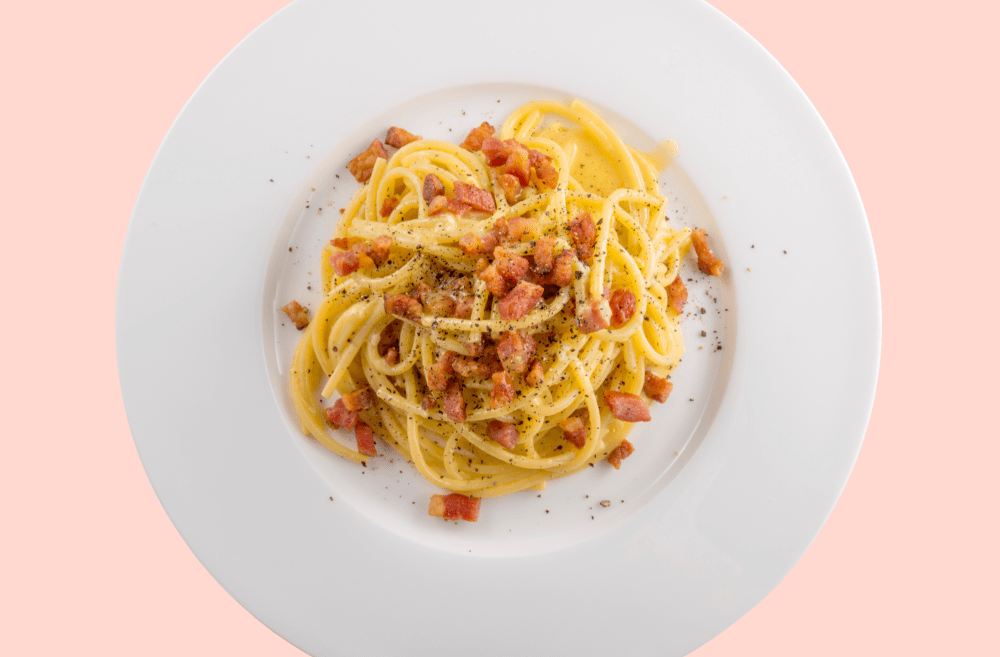For a dish containing just six ingredients, it’s remarkable just how much, and how often, spaghetti carbonara can go wrong. There’s nowhere to hide with this one; a flick of the wrist away from scrambled eggs, a rolling boil too many and it’s no longer to the tooth, overegg the cheese and it’s all gone toomami.
You get the picture; the small details really count. Because when done right, this is an unctuous, creamy, satisfying bowl of comfort. So with that in mind, let’s keep it simple; with these, our 5 steps to the perfect spaghetti carbonara.
THE POWER OF SIX
Or seven. But introduce unwelcome ingredients, and you’re in serious danger of disrupting the balance of what should be an incredibly straightforward dish. It’s no wonder, then, just how much passion the dish evokes in its fans.
First, let’s talk about cream. If you carry out each step in the cooking process with precision, then there’s absolutely no need for it. The emulsion of pasta water, egg yolk and cheese will create a sauce which needs no further enriching or thickening. Basically, add cream only to mask your failings. The same thing goes for any green leafed garnish; superfluous here and indicative of a cook trying to hide something.
Now that’s out the way, and assuming you’re cooking for two, get together 200 grams of dried spaghetti; dried as this gives you a little more wiggle room on achieving that toothsome quality. Next, you’ll want roughly 75g of diced pig’s cheek (guanciale). If you can’t get your hands on that, then pancetta is fine; what’s important is to have a good ratio of fat to meat. An equivalent amount of grated pecorino cheese and egg yolks (3 large ones will weigh about the same), a good crack of black pepper, and perhaps some garlic, and you’re good to go.
AL DENTE OR IT’S ALL OVER
Get a large pot filled deep with water onto a rolling boil, with enough salt added to make it taste like the sea. A good spaghetti carbonara is all about texture, and you want your pasta to still have a bit of give when cooked, or the interplay of creaminess and ‘to the tooth’ won’t work out right. It should take roughly 9 minutes, but check it at regular intervals. If you bite into a strand, you want to see a minute core whiteness running through the centre. That indicates you’re very nearly there, at which point you should drain it, remembering to reserve a good glug of pasta water.

FRYING THE FAT
While your pasta is boiling, you can fry off your pork. Do this over medium heat in a fairly high sided pan, allowing the fat to render properly in tandem with a crisping of the flesh. If your meat is fatty enough, you won’t need any olive oil. Once your guanciale or pancetta is crisp, it’s done. Take your frying pan off the heat (we’ll be using this pan again later).
Some folk fry off a little garlic in this process, some use a clove or two to perfume the oil or fat, and some leave it out entirely. We personally think it adds an additional layer of richness which isn’t really necessary, but it’s up to you.
MIX YOUR CHEESE & EGGS
During the pasta’s long roll to the finish line you can also prepare your sauce mixture. Simply whisk the egg yolks, cheese and black pepper together, in a mixing bowl, until fully incorporated and smoothish. Don’t salt just yet, as the finished article may well be saline enough.
DEATH OR GLORY
And lastly, the decisive part. Gently re-warm the pan containing the guanciale and pork fat, and add the drained pasta, mixing everything together with a pair of tongs. Remove from the heat, then add your egg and cheese mixture, along with a little of the reserved pasta cooking water, stirring and lifting with the tongs diligently to emulsify the liquid elements and prevent scrambled eggs. If you need a touch more of the cooking water to reach the desired creamy consistency, then add it; your call.
Check if a little additional salt is required, then serve with black pepper cracked over the top, a little more grated pecorino and a lot of pride.





